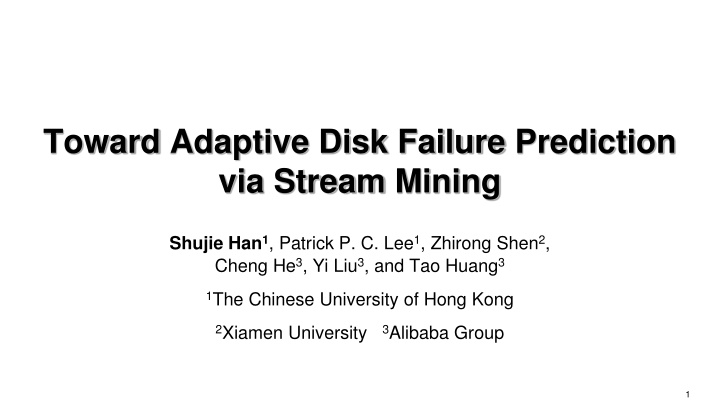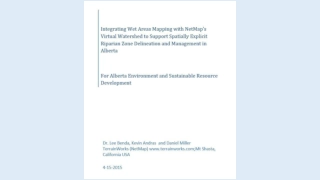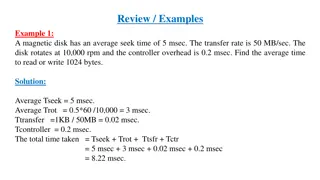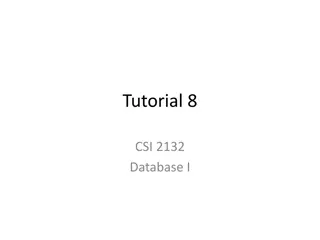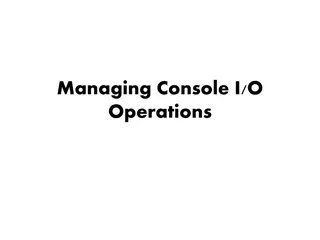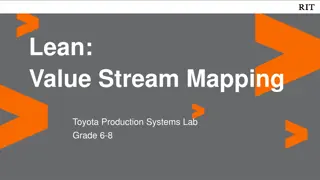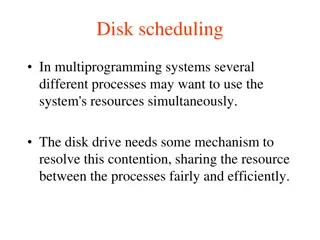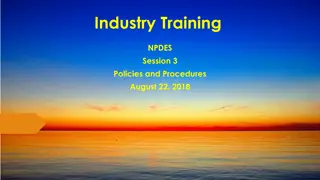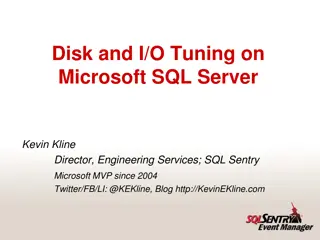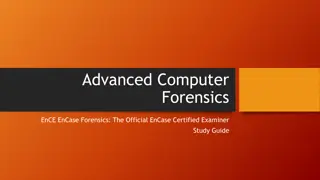StreamDFP: Adaptive Disk Failure Prediction via Stream Mining
StreamDFP introduces a general stream mining framework for disk failure prediction, addressing challenges in modern data centers. By predicting imminent disk failures using machine learning on SMART disk logs, it aims to enhance fault tolerance and reliability. The framework adapts to concept drift and achieves significant F1-score improvements through extensive evaluation on SMART datasets.
Download Presentation

Please find below an Image/Link to download the presentation.
The content on the website is provided AS IS for your information and personal use only. It may not be sold, licensed, or shared on other websites without obtaining consent from the author.If you encounter any issues during the download, it is possible that the publisher has removed the file from their server.
You are allowed to download the files provided on this website for personal or commercial use, subject to the condition that they are used lawfully. All files are the property of their respective owners.
The content on the website is provided AS IS for your information and personal use only. It may not be sold, licensed, or shared on other websites without obtaining consent from the author.
E N D
Presentation Transcript
Toward Adaptive Disk Failure Prediction via Stream Mining Shujie Han1, Patrick P. C. Lee1, Zhirong Shen2, Cheng He3, Yi Liu3, and Tao Huang3 1The Chinese University of Hong Kong 2Xiamen University 3Alibaba Group 1
Background Challenges of modern data centers (DCs) Disk failures are prevalent Correlated disk failures lead to data loss and unavailable services Traditional redundancy mechanisms (e.g., replication, RAID) are insufficient for strong reliability guarantees Proactive fault tolerance Predict imminent disk failures before actual failures happen based on machine learning Data: disk logs from SMART (Self-Monitoring, Analysis and Reporting Technology) 2
Motivation Existing disk failure prediction schemes are mostly offline All training data must be available before training any prediction model In practice Disk logs are continuously generated from disks over time Disk population is enormous in production environments Infeasible to keep all past data for training in a long-term use 3
Motivation How to generalize online disk failure prediction for various machine learning algorithms? Impractical to identify the best learning algorithm for all disk models Concept drift: statistical patterns of disk logs vary over time Due to aging of disks, or addition/removals of disks in production Difficult to identify proper window size of samples for training Too few samples insufficient samples to build an accurate prediction model Too many samples old samples cannot capture current failure characteristics 4
Our Contributions StreamDFP, a general stream mining framework for disk failure prediction Complete design and prototype Extensive measurement study on 5 SMART datasets Existence of concept drift Variations of concept drift across healthy/failed disks, disk models, and SMART attributes Evaluation of 9 decision-tree-based algorithms on 5 datasets Improve F1-score by 26.8-53.2% through concept-drift adaptation Fast stream processing 5
Disk Failure Prediction Formulate disk failure prediction as a stream mining problem ?? ???, failure status of disk ? at time ? ???, predicted failure status of disk ? at time ? positive (negative) samples correspond to failed (healthy) disks ?, SMART attributes emitted by disk ? at time ? Two types of prediction Classification: predict disk ? is healthy or failed Regression: predict likelihood that disk ? is failed 6
Concept Drift Relationship between input variables and target variable continuously changes over time Let ?0and ?1be two time points in a stream (assuming ?0< ?1) Let ?(??,??) be joint probability of ??and ??at time ? Concept drift occurs if ?(??0,??0) ?(??1,??1); prediction model cannot accurately map ??1to ??1 Bayesian decision theory: Changes of ? ???? can be characterized as changes in ? ??, ? ??, and ?(??|??) ? ???(??|??) ?(??) ? ???? = 7
Change Detection Identify existence of concept drift in ? ???? Absolute error ???for disk ? at time ?: ???= ??? ??? Take a stream of ??? s over a time window as input in change detection Change detectors ADaptive Sliding Window (ADWIN) [SDM 07], a variable-size sliding detection window of most recent samples Page-Hinckley (PH) test Drift Detection Model (DDM) 8
Incremental Learning Algorithms State-of-the-art algorithms based on decision trees Category Algorithm Hoeffding tree (HT) Hoeffding adaptive tree (HAT) Fast incremental model trees with drift detection (FIMT-DD) PH test Oza s bagging (Bag) Oza s boosting (Boost) Online random forests (RF) Bagging with ADWIN (BA) Boosting-like online ensemble (BOLE) Adaptive random forests (ARF) Change detector None ADWIN Classification tree Regression tree None None None ADWIN DDM ADWIN Ensemble learning 9
Datasets Overview of datasets Dataset ID Duration (months) Disk model Capacity Disk count # failures Period Seagate ST3000DM001 2014-01-31 to 2015-10-31 D1 3 TB 4,516 1,269 21 Seagate ST4000DM000 2013-05-10 to 2018-12-31 D2 4TB 37,015 3,275 68 Seagate ST12000NM0007 2017-09-06 to 2019-06-30 D3 12TB 35,462 740 22 Hitachi HDS722020ALA330 2013-04-10 to 2016-12-31 2019-01-01 to 2019-05-31 D4 2TB 4,601 226 45 Private disk model of Alibaba Cloud D5 6TB ~250 K ~1,000 5 10
Measurement Analysis Measurement of concept drift Measure changes of ? ??, ? ??, and ?(??|??) Measurement of ? ?? Percentages of failed disks (i.e., ???= 1) highly oscillate over time 11
Measurement Analysis Measurement of ? ?? Use two-sample Kolmogorov-Smirnov (KS) test to measure changes of SMART attributes (based on raw values) Compare samples in two time periods ?0and ?1 Null hypothesis: samples of ?0and ?1are drawn from same distributions A significant fraction of SMART attributes has changed distributions E.g., D2 has more than half of SMART attributes with changed distributions Changes of critical SMART attributes vary across datasets Change of ? ?? exists in two critical SMART attributes for D1 and D2, but not for D3 to D5 12
Measurement Analysis Measurement of ?(??|??) ?(??|healthy) and ?(??|failed) for healthy and failed disks, respectively Effects of changed distributions vary across disk models Failed disks show changed distributions in some critical SMART attributes Summary Changed distributions in ? ??, ? ??, and ?(??|??) indicate existence of concept drifts in ? ???? Changed behaviors cannot be readily predicted Mechanism for adapting to concept drift needs to be generally applicable for various changed behaviors 13
StreamDFP A general stream mining framework for disk failure prediction with concept-drift adaptation StreamDFP addresses following challenges: Online labeling Label samples on the fly based on current failure patterns Concept-drift-aware training Detect and adapt to concept drift in training General prediction Classification: answer if an unknown disk will remain healthy or will be failed Regression: determine likelihood that an unknown disk will fail 14
StreamDFP Design Feature extraction No or only few historical disk logs for feature selection in practice Use all collected SMART attributes as learning features Buffering and online labeling Buffer recently received samples into a sliding time window ? Label samples of soon-to-fail disks and actual failed disks as positive DL: number of extra labeled days before disk failure occurs Update labels of samples of all failed disks within DL ? ? ??+1 for regression For all ? [? DL,?], set ?? ?= 1 for classification and set ?? ?= 1 16
Design of StreamDFP Downsampling negative samples in a two-phase process Select a subset of samples in ? All positive samples and the negative samples in recent days (e.g., 7 days) Poisson sampling with customized hyper-parameters [ICPP 18] ??(??) for negatives (positives), and set ??> ??to ensure positives weigh more Training Train each decision tree with a labeled sample (?? Perform prediction to obtain ??? Compare ???and ???to detect if concept drift exists If so, decision tree is updated accordingly ?, ???) and its weight 17
Design of StreamDFP Prediction For classification, it predicts whether a disk failure will occur For regression, it returns the disk failure probability within near future Convert it to predicted residual lifetime of a disk: (1 ???)(?? + 1) Implementation and prototype Python for fast preprocessing data (~750 LoC) Java for training and prediction (~900 LoC) Realize all incremental learning algorithms and change detectors using Massive Online Analysis (MOA) [JLMR 10] 18
Evaluation Methodology Warm-up prediction model from scratch using the first 30 days Predict disk failures in next 30 days on a daily basis Total durations of evaluation: 400 days for D1 to D4 and 90 days for D5 Metrics Classification Precision, recall, and F1-score Regression Average relative error of the residual lifetime (ARE) 19
Evaluation Effectiveness of concept-drift adaptation Evaluate eight algorithms for classification Four pairs before and after enabling concept-drift adaptation Take D2 as an example Concept-drift adaptation improves overall F1-score for each pair of algorithms by up to 53.2% and mainly improves precision 20
Evaluation Sensitivity of extra labeled days (D2 as an example) Vary DLfrom 0 to 30 days for BA, BOLE, and ARF Introducing extra labeled days (DL> 0) increases prediction accuracy in general Optimal value of DLvaries across algorithms and datasets 21
Evaluation Accuracy of regression Evaluate ARE with FIMT-DD Predicted likelihood of disk failures is close to actual likelihood Means of ARE are -0.0014, -0.27, 0.13, 0.29, and 0.58 (in days) ARE for D4 is up to +20 days Failure symptoms (e.g., sector errors) for D4 last longer due to older average age 22
Evaluation Impact of false positive rate (FPR) thresholds Prediction accuracy of Bag and BA for D2 vs. FPR threshold (0.5-2%) BA improves precision and F1-score significantly, while preserving recall 23
Evaluation Execution performance Breakdown of per-day execution time for D2 Standard deviations of all five runs are in brackets StreamDFP performs training and prediction within 13.5 seconds on daily SMART data of 37 K disks overall Feature extraction 0.0055 s (0.069 ms) Online labeling 0.42 s (30.8 ms) Step Buffering Downsampling Training Prediction 0.093 s (9.6 ms) 0.52 s (19.0 ms) 10.6 s (0.75 s) 1.9 s (0.14 s) Time 24
Conclusion StreamDFP is a general stream mining framework for disk failure prediction with concept-drift adaptation Prototype implementation of StreamDFP Measurement study of concept-drift On 5 SMART datasets from Backblaze and Alibaba Cloud Evaluation on prediction accuracy and processing performance Improve prediction accuracy significantly and support fast processing Source code: http://adslab.cse.cuhk.edu.hk/software/streamdfp 25
Thank You! Q & A 26
